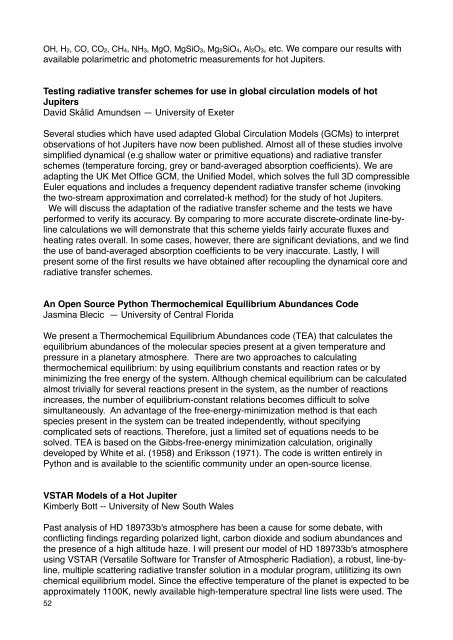Exoclimes_Conference_booklet1
Exoclimes_Conference_booklet1
Exoclimes_Conference_booklet1
Create successful ePaper yourself
Turn your PDF publications into a flip-book with our unique Google optimized e-Paper software.
OH, H2, CO, CO2, CH4, NH3, MgO, MgSiO3, Mg2SiO4, Al2O3, etc. We compare our results with<br />
available polarimetric and photometric measurements for hot Jupiters.<br />
Testing radiative transfer schemes for use in global circulation models of hot<br />
Jupiters!<br />
David Skålid!Amundsen — University of Exeter!<br />
Several studies which have used adapted Global Circulation Models (GCMs) to interpret<br />
observations of hot Jupiters have now been published. Almost all of these studies involve<br />
simplified dynamical (e.g shallow water or primitive equations) and radiative transfer<br />
schemes (temperature forcing, grey or band-averaged absorption coefficients). We are<br />
adapting the UK Met Office GCM, the Unified Model, which solves the full 3D compressible<br />
Euler equations and includes a frequency dependent radiative transfer scheme (invoking<br />
the two-stream approximation and correlated-k method) for the study of hot Jupiters.<br />
We will discuss the adaptation of the radiative transfer scheme and the tests we have<br />
performed to verify its accuracy. By comparing to more accurate discrete-ordinate line-byline<br />
calculations we will demonstrate that this scheme yields fairly accurate fluxes and<br />
heating rates overall. In some cases, however, there are significant deviations, and we find<br />
the use of band-averaged absorption coefficients to be very inaccurate. Lastly, I will<br />
present some of the first results we have obtained after recoupling the dynamical core and<br />
radiative transfer schemes.<br />
An Open Source Python Thermochemical Equilibrium Abundances Code!<br />
Jasmina Blecic — University of Central Florida<br />
We present a Thermochemical Equilibrium Abundances code (TEA) that calculates the<br />
equilibrium abundances of the molecular species present at a given temperature and<br />
pressure in a planetary atmosphere. There are two approaches to calculating<br />
thermochemical equilibrium: by using equilibrium constants and reaction rates or by<br />
minimizing the free energy of the system. Although chemical equilibrium can be calculated<br />
almost trivially for several reactions present in the system, as the number of reactions<br />
increases, the number of equilibrium-constant relations becomes difficult to solve<br />
simultaneously. An advantage of the free-energy-minimization method is that each<br />
species present in the system can be treated independently, without specifying<br />
complicated sets of reactions. Therefore, just a limited set of equations needs to be<br />
solved. TEA is based on the Gibbs-free-energy minimization calculation, originally<br />
developed by White et al. (1958) and Eriksson (1971). The code is written entirely in<br />
Python and is available to the scientific community under an open-source license.<br />
VSTAR Models of a Hot Jupiter<br />
Kimberly Bott -- University of New South Wales<br />
Past analysis of HD 189733b's atmosphere has been a cause for some debate, with<br />
conflicting findings regarding polarized light, carbon dioxide and sodium abundances and<br />
the presence of a high altitude haze. I will present our model of HD 189733b's atmosphere<br />
using VSTAR (Versatile Software for Transfer of Atmospheric Radiation), a robust, line-byline,<br />
multiple scattering radiative transfer solution in a modular program, utilitizing its own<br />
chemical equilibrium model. Since the effective temperature of the planet is expected to be<br />
approximately 1100K, newly available high-temperature spectral line lists were used. The<br />
52


